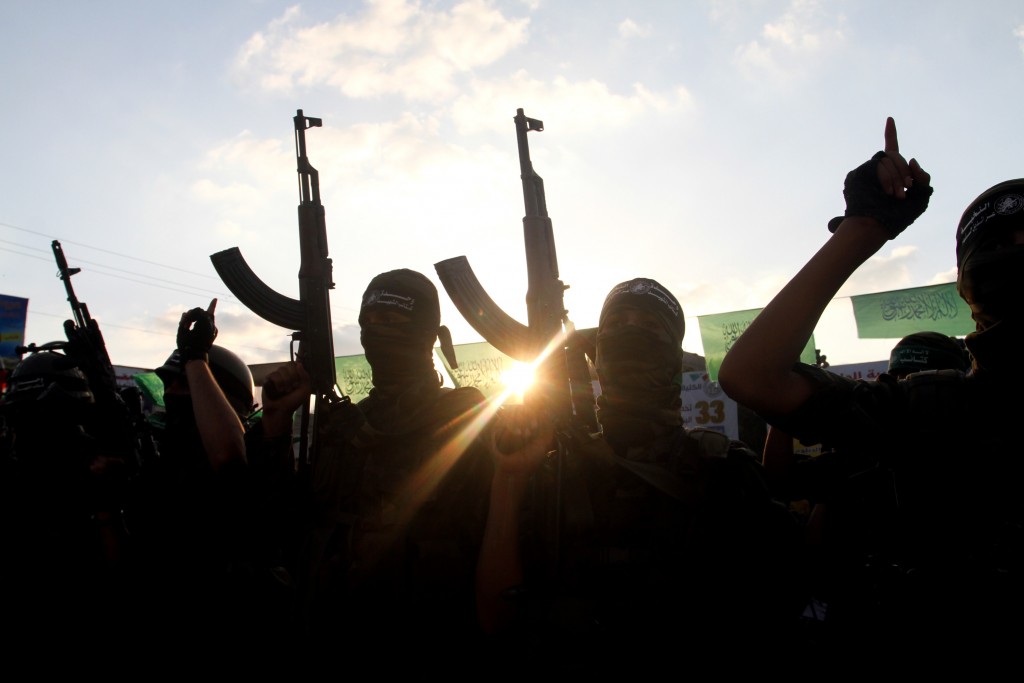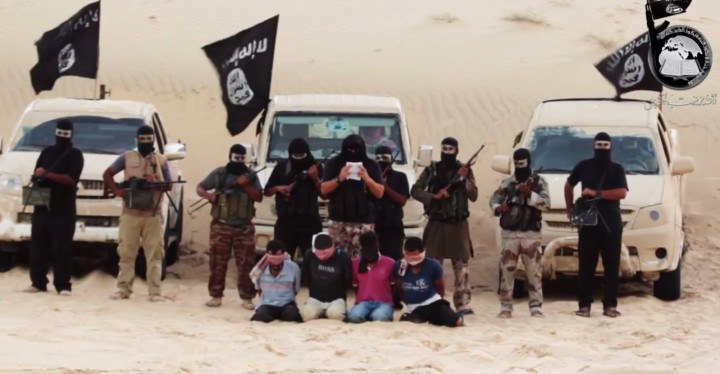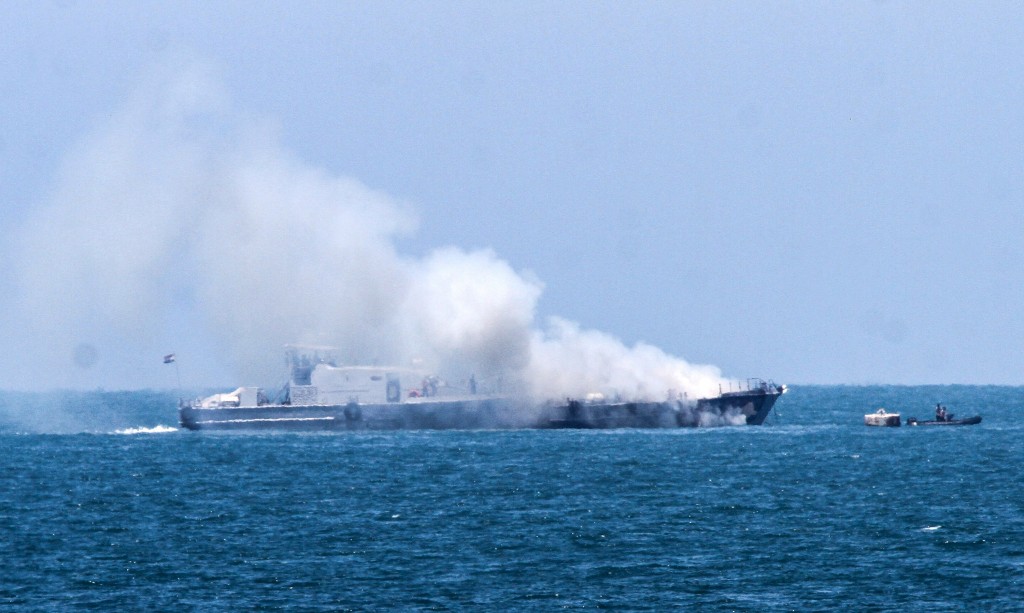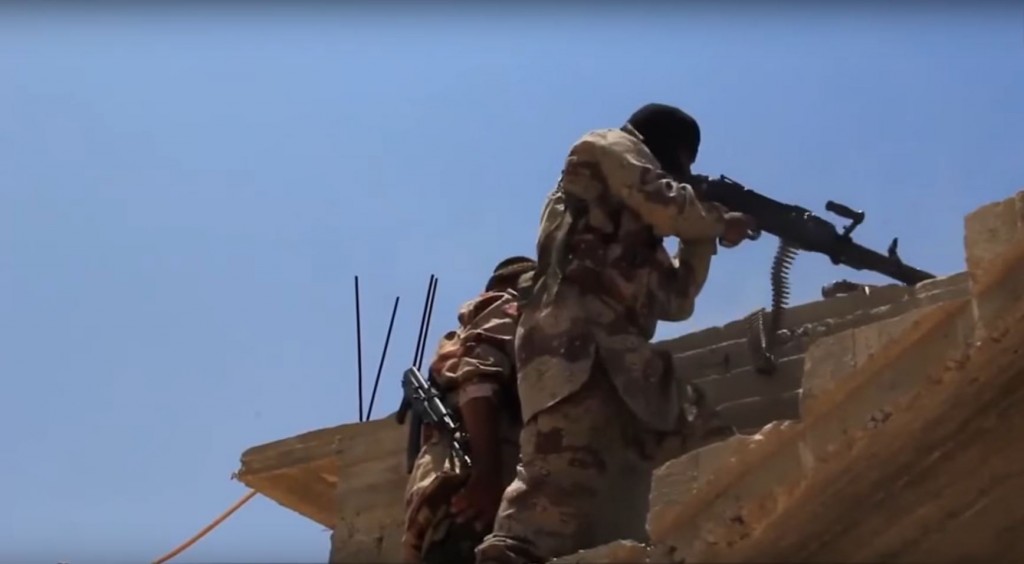The ISIS-Hamas-Iran triangle is leading to violence and instability in Egypt, Gaza, and soon, possibly Israel.
Most people assume that the Sunni terrorist group ISIS is the natural and mortal enemy of Shia Iran, but this is not always the case. In fact, in at least one part of the Middle East, Iran has become a crucial, if indirect, sponsor of its supposed enemy.
As the world’s eyes are focused on ISIS terrorism in Europe, the Middle East, and even the U.S., the group’s branch in the Sinai has become one of the most powerful, dangerous, and effective in the region. Recent reports indicate that Iran, through the Palestinian terrorist group Hamas, is primarily responsible for this.
The Iran-Hamas-ISIS axis is part of Iran’s strategy of using proxy forces against U.S. allies like Egypt and Israel as part of a larger strategy to achieve hegemony over the Middle East. This has resulted in one of the region’s best kept secrets: An intensive cooperation mechanism between Iran, Hamas, and ISIS, based on money, weapons, military equipment, and training.
Iran’s foreign policy goal of hegemony over the Middle East is based on its primary ideological pillar – exporting the Islamic Revolution to other countries using terrorism and political subversion. In pursuing its ambitions, Iran has often put aside its religious differences with radical Sunni groups like ISIS and Hamas. The Islamic Republic is more than willing to cooperate with these groups as long as doing so helps promote its larger interests.
“By directly supporting Hamas in Gaza and indirectly supporting ISIS in the Sinai, Iran is able to gain foothold against Israel and Egypt to destabilize them, undermine America’s regional influence, create another Iranian power base in a Sunni-dominated region, and project its power and influence in its pursuit of regional hegemony,” Major (res.) Dan Feferman, a former senior IDF intelligence officer and Iran specialist, told the Tower. When asked why Iran would indirectly fund a serious rival such as ISIS, Feferman said that Lebanon, Iraq, and especially Syria are more important to Iran than the Sinai, as Iran wants to preserve its influence in states affected by the Syrian civil war – so Iran fights ISIS in those counties. In places where Iran does not have a strong influence, such as Egypt, it feels comfortable supporting ISIS, albeit indirectly.
“Just like Iran needs ISIS in Syria and Iraq to maintain its relevance among world powers such as Russia and the United States, it has no problem with ISIS gaining strength in Sinai for the time being,” added Brigadier General (res.) Yossi Kuperwasser, former Director General of the Israeli Ministry of Strategic Affairs and former head of Israeli intelligence’s Research and Assessment Division added. “If ISIS gains more power in the Sinai and Iran is able to help demean that power in the future, it will once again position itself as an address to world powers and thus demand something in return. Moreover, as long as Iran is able to weaken the moderate Sunni Arab state alliance of Egypt, Saudi Arabia and Jordan by indirectly supporting ISIS Sinai through Hamas, it won’t stop doing so.”
But Iran’s support of ISIS via Hamas goes deeper than mere strategic considerations. Despite the deep ideological rifts between Iran, Hamas, and ISIS in Sinai, as well as the traditional animosity between Shias, Sunnis, and Salafists, all three groups see each other as temporary partners in
1. The destruction of the state of Israel.
2. Undermining the peace process between Israel and the Palestinian Authority, as well as Palestinian Authority President Mahmoud Abbas’ authority.
3. Opposing and destabilizing Egyptian President Abdel Fattah al-Sisi’s Western-oriented regime, especially in regard to its peace treaty with Israel.
4. Harming U.S. interests in the region and undermining its presence in the Middle East as a whole.
5. Bridging the Sunni-Shia divide and reconstituting a Muslim caliphate.
For Iran, Hamas and ISIS serve different aspects of these ambitions. Iran uses Hamas to deepen the conflict between Israel and the Palestinians by supporting Palestinian terror and a rejectionist approach to the peace process. It uses ISIS in the Sinai against al-Sisi and to further its vision of a caliphate dominated by Iran.
Iran could not support ISIS in Sinai or pursue its ambitions against Israel and Egypt without Hamas. The relationship between the terrorist organization and Iran is deep and of long standing. Indeed, Iran has provided funding, weapons, training, technology, and political support to Hamas for decades.
This relationship began almost simultaneously with the founding of Hamas, and has intensified every time the peace process appeared to be gaining momentum. In October 1991, Iran convened a conference in Tehran whose purpose was to unite various radical organizations led by Hamas who were hostile to the PLO’s negotiations with Israel at the Madrid peace summit. The groups gathered in Tehran called for the destruction of Israel and pledged to make every possible effort to sabotage the newborn peace process, which was seen as a direct threat to their strategic goals.
Iran-Hamas relations were officially formalized in October 1992, when a Hamas delegation led by then-Secretary General Mousa Abu-Marzuq visited Tehran for talks. Iran permitted Hamas to open an office in Tehran, provided it with millions of dollars in cash, and agreed to have the elite Iranian Revolutionary Guard Corps train thousands of Hamas members in Hezbollah camps in Lebanon.
This initially lukewarm relationship became a full-blown alliance when the second intifada began in 2000. Iran began funding, recruiting, directing, training, and supporting Palestinian terrorists and building the infrastructure to support them. This included carrying out suicide bombings, paying the families of terrorists, and providing monthly salaries to terrorists in Israeli jails.

Hamas soldiers take part in a military parade marking the first anniversary of the killing of Hamas’s military commanders Mohammed Abu Shammala and Raed al-Attar, in Rafah, Gaza Strip, August 21, 2015. Abu Shammala and al-Attar were killed by an Israeli air strike during a 50-day war between the terror group and Israel the previous summer. Photo: Abed Rahim Khatib / Flash90
The Israeli disengagement from the Gaza Strip in August 2005 created a new reality. Hamas won the Palestinian Legislative Council elections in January 2006, which resulted in a significant increase in Iranian funding. Immediately following the elections, Hamas leader Khaled Mashaal visited Iran and secured an estimated $20 million per month from the Islamic Republic – enough to cover Hamas’ entire budget. This was followed by a visit from Hamas’ former Prime Minister Ismail Haniyeh, in which Iran pledged $250 million in aid. The funds were earmarked to pay the wages of civil servants, bankroll Hamas security forces, and compensate Palestinian families that lost their homes during Israeli military operations.
In June 2007, Hamas carried out a putsch in the Gaza Strip, neutralized Fatah and the Palestinian Authority’s military and political power, and set up a radical Islamic government. Following the takeover, Iran became a patron of the new Gaza regime, providing Hamas with military, financial, political, and media support. Iran saw the establishment of Hamas rule in the Gaza Strip as a way to wage an armed campaign against Israel and advance its influence in the Palestinian arena. The exposure of the Israeli home front to rocket fire during three rounds of armed confrontation between Israel and Hamas showed the Iranians the great benefits they could reap by constructing a military infrastructure for Hamas.
As a result, Iranian money, equipment, and military expertise keep flowing to Hamas and then to ISIS.
Despite some rifts between Iran and Hamas’ political wing since 2012 (stemming from Hamas moving its headquarters from Syria and refusing to follow the Iranian line by supporting President Bashar al-Assad), the Times of Israel reported in September that, boosted by the nuclear deal, Iran has increased its funding to Hamas’ military wing with literally “suitcases of cash” sent directly to leaders in the Gaza Strip. Moreover, The Wall Street Journal and The Daily Telegraph quoted top senior Western intelligence officials in April saying that Iran’s Revolutionary Guards have transferred tens of millions of dollars to Hamas.
The heads of Hamas’ military wing are focused on one objective: Preparing for the next war with Israel. To them, anyone who can help them achieve that goal is an ally. They have no problem with receiving money from Iran while at the same time cooperating with ISIS in the Sinai. Indeed, they have been doing both for a long time.
The ongoing cooperation between Hamas and ISIS in Sinai began even before Hamas took over the Strip in 2007. It started when Hamas began cultivating relations with Bedouin tribes and Palestinians living in the Sinai. At the time, ISIS’s branch in Sinai was still known by its previous name, Ansar Bait al-Maqdis (ABAM).
ABAM was a radical Salafi group formed in the early 2000s by international jihadists, mainly from Egypt, Libya, and Saudi Arabia. They arrived in Sinai in order to take advantage of al-Qaeda’s international success following the September 11 attacks, and pledged their allegiance to the terrorist group. These jihadists used a local infrastructure of Bedouin tribes and Palestinian Salafi extremists who had left or fled from Gaza after being discharged from Hamas and other terror groups in the Strip. Some of the extremists had found Hamas’ policy to be too moderate after various agreements reached with Israel.
The jihadists rightfully saw that the Egypt’s hold on Sinai was weak. As a result, it was a place where they could operate for an extended period of time without risk of being wiped out by Egyptian security forces. Accordingly, ABAM established its headquarters in mountainous areas with no Egyptian presence and extremely difficult conditions on the ground.
On October 7, 2004, the organization executed its first attack that included Palestinians from Gaza, according to Egyptian sources. Joint Palestinian, Egyptian, and Bedouin terror cells detonated three car bombs at tourist sites in Sinai that attracted Israeli vacationers. Forty-three people were killed in the attacks – including 21 Israelis – and 171 wounded.

Ansar Bait al-Maqdis, the Egyptian terror group that pledged its allegiance to ISIS in November 2014, prepares to execute captives. Photo: Day Donaldson / flickr
Hamas-ABAM cooperation expanded after Israel pulled out of the Gaza Strip, when the smuggling of people, goods, food, weapons, and fuel through tunnels under the Egyptian border into Gaza increased exponentially. ABAM and Sinai Bedouins made a fortune from the smuggling, which served to cement the connection between Hamas and ABAM. U.S. State Department cables that were released by Wikileaks revealed that the Egyptian government believed that Iran was also trying to recruit Bedouins to smuggle arms into Gaza.
ABAM escalated its activity against Israel on August 18, 2011, when a bus was targeted in a combined terror attack in Eilat. Israeli officials said Hamas militants from Gaza were responsible, although the Hamas government denied it. They did, however, praise the attack. In July 2012, ABAM claimed responsibility for a series of explosions that shattered natural gas pipelines from Egypt to Israel. And from 2010-2014, the organization fired rockets several times toward southern Israeli communities.
In recent months, and especially since November 2014, when ABAM swore allegiance to ISIS, Hamas has been increasing its clandestine military cooperation with the group.
Hamas’ ongoing cooperation with ISIS-Sinai has been quite controversial among its top echelons. Therefore, the group’s Political Bureau has seemingly refrained from making a decision about reaching out to ISIS-Sinai and has turned a blind eye to this activity. Instead, the cooperation is reportedly managed by a group of high-ranking military wing commanders.
A serious rift has opened between the organization’s military and political wings over the question of allying with Iran, and as a result of continued Iranian support, Hamas’ military wing has grown to dominate its political counterpart.
The leadership of the military wing certainly knows and approves of the cooperation with ISIS. Indeed, it has a clear hierarchy and its members are trained to obey orders; a relationship as intensive as Hamas-ISIS cooperation cannot exist without the approval of its high command. Moreover, Hamas’ military wing has its own budgetary mechanism not bound to the political echelon. A significant amount of its funds come from Iran via massive bank transfers. This is the money Hamas has used to turn ISIS in Sinai from a small gang of Bedouins into a formidable terrorist organization.
Moreover, Egyptian officials keep pointing an accusing finger at Hamas, asserting there is no doubt that elements belonging to Palestinian factions were directly involved several terrorist attacks against Egyptian forces.
According to recent reports by the Times of Israel and Ynet, three men are at the forefront of Hamas’ support for ISIS: Former Hamas interior minister Fathi Hamad, former commander of Hamas’ Central District Brigade Ayman Nofal, and a former high-ranking operations officer in Hamas’ military wing, Abdullah Mohammed Sayyid Kishta.
This trio is a paradigmatic example of how Hamas’ military wing aids and supports ISIS in Sinai. Nofal developed Hamas’ system of safe houses and collaborators among the Sinai Bedouins. Kishta was dispatched to the Sinai through one of the tunnels under Egyptian border and instructed ISIS in the use of anti-tank missiles and advanced explosive devices. Hamad is well-known as one of the most radical figures in Hamas today; he was head of its security services in Gaza and is very influential within the military wing. He is thought to be one of the main points of contact between Hamas and ISIS fighters in Sinai.
The training and technological know-how that Hamas received from Iran are a major aspect of cooperation between Hamas and ISIS. Members of Hamas’ military wing have helped train and equip ISIS operatives in Gaza and the Sinai itself. ISIS members who cross into Gaza undergo training and military studies with Hamas. These ISIS fighters then teach Hamas and Iran’s military doctrines to their operatives in Sinai. As a result, ISIS attacks have become more lethal and effective. And ISIS has been given access to several weapons caches and sophisticated military equipment by Hamas.
Hamas’ support of ISIS doesn’t stop with military aid and know-how; it also provides medical assistance and takes wounded ISIS fighters to hospitals in the Gaza Strip, where they are treated under Hamas supervision. In addition, Hamas sends its own medical staff to the Sinai in order to treat ISIS fighters in the field.
The cooperation between Hamas and ISIS culminated in December 2015, with a prolonged secret visit to Gaza by ISIS’s Sinai military chief Shadi al-Menei ¬– the man responsible for transferring ABAM’s allegiance from Al-Qaeda to ISIS. Al-Menei held talks with his counterparts in Hamas’ military wing in order to foster further collaboration and coordinate attacks on Egyptian and Israeli targets, though some Hamas officials denied the visit took place. Al-Menei was behind a 2011 terrorist attack in southern Israel in which four groups of terrorists targeted a bus and several Israeli army vehicles, as well as sporadic rocket fire on the southern Israeli town of Eilat. It wasn’t the first time al-Menei made the journey. After being placed atop Egypt’s most wanted list following an attempt to assassinate him in May 2014, he hid in Gaza for months under the protection of the heads of the Hamas military wing.

Smoke billows from an Egyptian naval vessel on the maritime border between Egypt and the Gaza Strip, July 16, 2015. The Egyptian military said that the vessel was set ablaze during a clash with militants in the Sinai Peninsula. Photo: Abed Rahim Khatib / Flash90
Al-Menei’s visit was part of a growing trend. The shared desire to protect smuggling routes and the need for good relations with Sinai Bedouin tribes has led to closer ties between ISIS commanders in Sinai and high-ranking members of Hamas’ military wing. ISIS in Sinai enables Hamas to move weapons from Iran and Libya through the Sinai Peninsula, taking a generous cut from each shipment. Hamas relies on Bedouin guides to avoid detection by the Egyptian army and reach the few tunnels that have survived Cairo’s aggressive flooding and closure campaign in June 2013, which left only a few tunnels fully operational. As a result, Hamas-ISIS collaboration is essential to both groups, giving them a constant supply of arms, combat forces, instructors, and advisers, while collecting huge profits from the smuggling industry.
All of this could lead to a significant change in the strategic threat to Israel. Israeli officials believe that if the situation escalates on the Gaza front, both ISIS in the Sinai and ISIS in Gaza – and maybe some ISIS cells in the West Bank – will aid Hamas in its fight against the IDF. This would, in turn, give Iran the ability to open another indirect front against Israel in tandem with Hamas and Hezbollah.
Ironically, the close coordination between Hamas’ military wing and ISIS in Sinai does not mitigate Hamas’ intensive efforts against homegrown ISIS-style Salafists in the Gaza Strip. In the case of Gaza-based Salafist groups, like the Omar Hadid Brigade, Hamas’ attitude is completely different than toward ISIS. Hamas is in the midst of a serious conflict with Gaza-based ISIS sympathizers. It is cracking down, sometimes with the use of force, against these groups and restraining their activity against Israel when it jeopardizes the fragile ceasefire. Tellingly, while ISIS leaders in Syria and Iraq have openly denounced Hamas, the Sinai affiliate refrains from echoing these statements and has offered no public support for ISIS-style groups in Gaza.
Through the Iran-Hamas-ISIS axis, the Sinai branch of what it is now viewed as the world’s most dangerous terrorist group is flush with Tehran’s money, weapons, technology, and expertise. And Iran is well aware of this. Hamas’ military wing is dependent on Tehran for its funds and equipment, and would not risk a rift with Iran by consorting with ISIS without Iran’s approval. Hamas is short of funds and understands, more than ever, that it needs Iran for financial and operational support, especially in view of the deteriorations of its relations with Egypt and its bruising fight with Israel.
Moreover, Iran has also continued arms deliveries to Hamas through the Red Sea and the Sinai even though it must be aware of the fact that ISIS will take its cut of these shipments as payment for helping smuggle them into the Gaza Strip.
In short, Iran knows Hamas is aiding and abetting ISIS in Sinai, and Hamas knows that Iran knows it.
Currently, the world is fixated on ISIS as the next major threat in the war on terror. By contrast, Iran is seen as an emerging ally soon to be reconciled with the West, especially after the signing of the nuclear deal. But the two are indirectly intertwined. Iran’s clandestine aid helps ISIS toward its goal of destabilizing Egypt and expanding the size of its “Sinai Province” of the larger ISIS “caliphate.” At the same time, ISIS’s terrorism serves Iran’s imperial ambitions of expanding its influence throughout the Middle East., Iran and ISIS are two sides of the same coin, and when it suits them, they are more than happy to become friends.
![]()
Banner Photo: David Katz / The Israel Project / flickr






